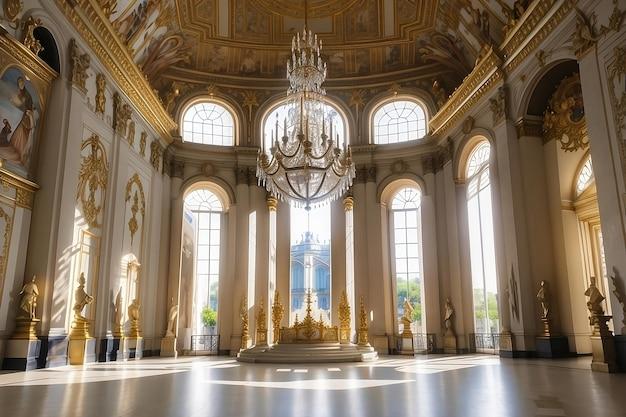The year 1919 marks a significant turning point in world history, as it was during this time that the renowned Palace of Versailles became the stage for a momentous event. The Paris Peace Conference, held at the Palace of Versailles, brought together world leaders to negotiate the terms and conditions for peace in the aftermath of World War I. This conference ultimately led to the creation of the Treaty of Versailles, a document that aimed to restore stability and prevent future conflicts.
In this blog post, we will delve into the key details surrounding the event that took place at Versailles in 1919. We will explore the motivations behind the rejection of the Treaty of Versailles by the United States, examine the significance of the League of Nations proposed at Versailles, and uncover how the League sought to improve lives in the aftermath of the war. Additionally, we will discuss the impact of the Great Depression on the League and the challenges it faced during this turbulent period.
Join us as we embark on a journey to understand the crucial events and decisions that shaped the world order after World War I at the iconic Palace of Versailles. So grab a cup of coffee and get ready to delve into this fascinating chapter of history!
Estimated reading time: 4 minutes
What Happened at Versailles in 1919
A Historic Gathering of Nations
In 1919, amidst the aftermath of World War I, the illustrious Palace of Versailles bore witness to a momentous event that would not only shape the course of history but also provide material for countless history textbooks and (hopefully) entertaining blog posts. This event, my dear readers, was none other than the Versailles Conference, also known as the Paris Peace Conference.
The Magnificent Palace Sets the Stage
Picture this: the sun-drenched Hall of Mirrors, adorned with sparkling chandeliers and ornate furnishings fit for royalty, was transformed into a hub of diplomatic negotiations. Here, heads of state, diplomats, and delegates from various countries came together to engage in discussions that would define the new world order.
The Treaty of Versailles: A Double-Edged Sword
The centerpiece of the Versailles Conference was the Treaty of Versailles, a document that sought to bring a semblance of peace and stability to a war-torn world. However, as we all know, good intentions don’t always lead to desirable outcomes. While the treaty aimed to punish the Central Powers and prevent future conflicts, its terms planted seeds of resentment and sowed the seeds of future animosity.
The Impact on the United States
With a nod to my readers across the pond, let’s not forget the role the United States played in this grand affair. President Woodrow Wilson, armed with his famous Fourteen Points and a vision for a fair and just peace, embarked on a journey across the Atlantic to participate in the negotiations. It was a monumental task, indeed, as Wilson navigated not only the treacherous waters of international diplomacy but also the treacherous waters of French cuisine. Rumor has it the escargots didn’t sit well with him!
The League of Nations: An Ideal Turned Real
Ah, the League of Nations, the brainchild of President Wilson and the embodiment of his dreams for a world governed by collective security and international cooperation. Alas, while the League of Nations did come into existence as part of the Versailles settlement, its effectiveness was compromised by a lack of support from certain influential nations (cough United States cough) and its inability to prevent the outbreak of World War II.
Lessons Learned and Historical Reflections
As we reflect on the events that unfolded at Versailles in 1919, it’s crucial to acknowledge the complex mixture of idealism, political maneuvering, and unintended consequences that emerged from this gathering. The Treaty of Versailles, for all its flaws, serves as a reminder that even the most well-intentioned efforts can have far-reaching and unforeseen ramifications.
So, dear readers, now you know what happened at Versailles in 1919. The Versailles Conference, with its dazzling setting and intricate negotiations, set the stage for a new era in international diplomacy. But alas, we can also witness the shadows cast by the treaty’s terms and the League of Nations’ limitations. Whether you view it as a fascinating historical episode or a cautionary tale, one thing is certain: the events that transpired at Versailles in 1919 continue to captivate our imaginations and shape our understanding of the world.
Don’t forget to keep your pinky finger raised while sipping your tea and discussing the Treaty of Versailles at your next social gathering. It adds a touch of class and historically relevant humor!
FAQ: What event took place at Versailles in 1919
After the ravages of World War I, a momentous event took place at Versailles in 1919 that shaped the course of history. Let’s dive into some frequently asked questions about this pivotal event and its consequences.
Why did the US reject the Treaty of Versailles
The Treaty of Versailles, which ended World War I, faced significant opposition from the United States. Here’s why:
1. Discontent with Wilson’s Fourteen Points
President Woodrow Wilson’s Fourteen Points served as the foundation for the Treaty of Versailles. However, in the US, there was growing dissatisfaction with Wilson’s idealistic approach and belief in international cooperation.
2. Concerns over Loss of Sovereignty
The US Senate was particularly wary of the provisions that would involve the nation in foreign affairs. Many lawmakers feared that joining the League of Nations, which was proposed under the treaty, would undermine America’s sovereignty and independence.
3. Political Debates and Partisan Divisions
Political rivalries and disagreements within the US Congress played a significant role in the rejection of the Treaty of Versailles. Some senators saw it as an opportunity to challenge President Wilson’s authority and assert their own political agendas.
Who proposed the League of Nations
The League of Nations was a precursor to the United Nations and aimed to foster international cooperation and prevent future conflicts. But who came up with the idea?
It was President Woodrow Wilson!
President Wilson proposed the establishment of the League of Nations as part of his Fourteen Points, which he presented to Congress in January 1918. Wilson believed that collective security and diplomacy could lead to a more peaceful world.
How did the League of Nations improve people’s lives
The League of Nations had various initiatives aimed at improving the lives of people across the globe. Here are some notable achievements:
1. Promoting International Health
The League of Nations played a crucial role in combating deadly diseases and promoting public health. It established the Health Organization, which worked to prevent the spread of epidemics and improve healthcare standards worldwide.
2. Protecting Minority Rights
The League of Nations endeavored to protect the rights of minority groups, ensuring they were not oppressed or discriminated against. By advocating for minority rights, the League sought to prevent conflicts rooted in ethnic or religious tensions.
3. Disarmament Efforts
To maintain peace and reduce the likelihood of future wars, the League of Nations encouraged disarmament among member states. Its programs aimed to limit the arms race and promote cooperative security measures.
What event took place at Versailles 1919
The event that took place at Versailles in 1919 was the signing of the Treaty of Versailles, marking the official end of World War I. The treaty, signed between Germany and the Allied Powers, sought to impose harsh penalties on Germany and reshape the geopolitical landscape of Europe.
Why did the depression cause problems for the League
The Great Depression, which began in 1929, had a detrimental impact on the League of Nations. Here’s why:
1. Economic Instability and Protectionism
The economic downturn led to widespread protectionism, with countries imposing tariffs and trade barriers to shelter their own industries. Such protectionist measures undermined the League’s efforts to promote free trade and international economic cooperation.
2. Financial Strain on Member States
The economic crisis put significant financial strain on member states, making it difficult for them to fulfill their financial obligations to the League. Many nations were preoccupied with their domestic economic issues and reduced their commitments to international organizations like the League.
3. Rising Nationalism and Isolationism
The Great Depression fueled a sense of nationalism and isolationism in many countries. As nations became more inwardly focused, the spirit of international cooperation championed by the League of Nations lost momentum, making it increasingly challenging to address global issues collectively.
The Treaty of Versailles and the subsequent establishment of the League of Nations were significant milestones in history. Understanding the events, decisions, and consequences of this period allows us to grasp the complexities that shaped the world as we know it today.

